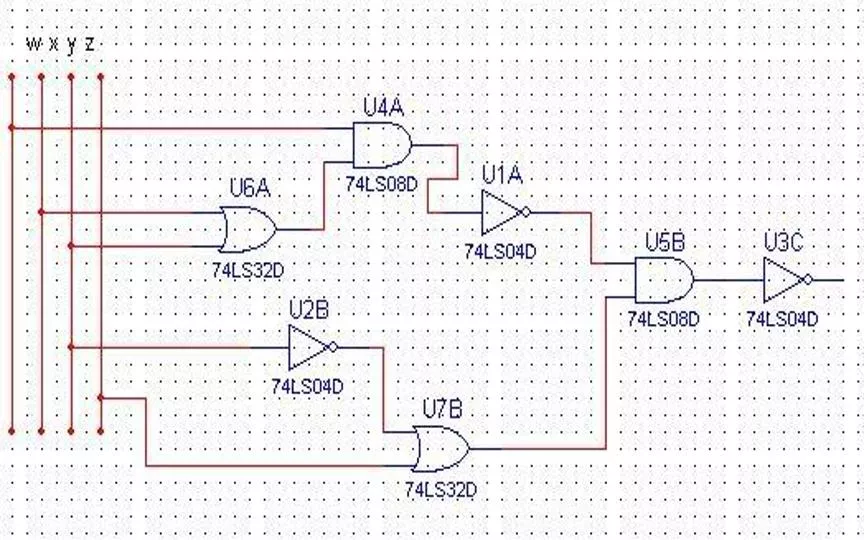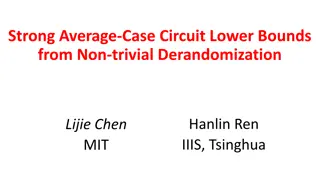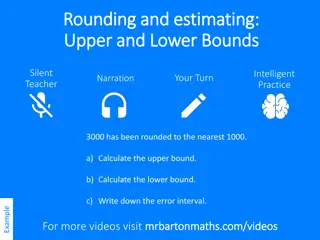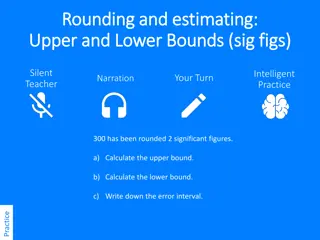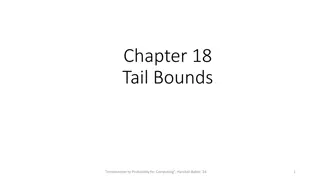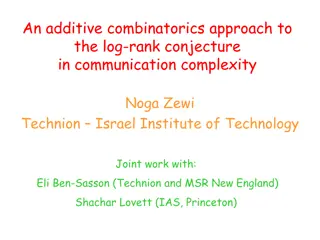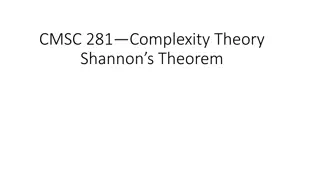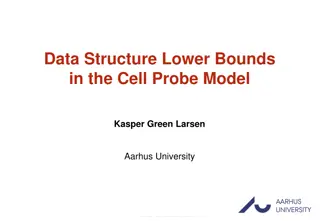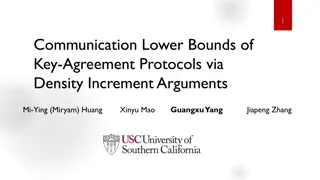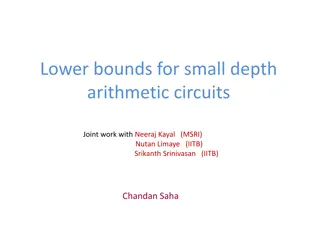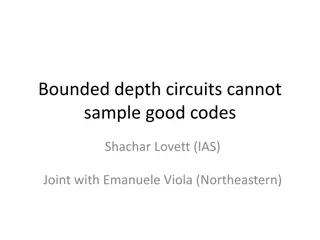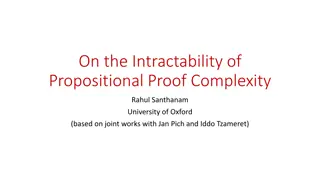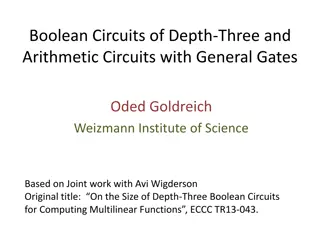Non-Uniform ACC Circuit Lower Bounds
Non-Uniform ACC circuits play a crucial role in circuit lower bound research. Explore the history, theorems, and implications behind these circuits in the context of complexity theory.
Download Presentation

Please find below an Image/Link to download the presentation.
The content on the website is provided AS IS for your information and personal use only. It may not be sold, licensed, or shared on other websites without obtaining consent from the author.If you encounter any issues during the download, it is possible that the publisher has removed the file from their server.
You are allowed to download the files provided on this website for personal or commercial use, subject to the condition that they are used lawfully. All files are the property of their respective owners.
The content on the website is provided AS IS for your information and personal use only. It may not be sold, licensed, or shared on other websites without obtaining consent from the author.
E N D
Presentation Transcript
Non-Uniform ACC Circuit Lower Bounds MOD6 MOD6 Ryan Williams IBM Almaden
The Circuit Class ACC An ACC circuit family {Cn} has the following properties: Each Cn takes n bits of input and outputs a bit The gates of Cn can be AND, OR, NOT, MODm MODm(x1, ,xt) = 1 iff i xi is divisible by m Cn has constant depth (independent of n) Remarks 1. The default size of nth circuit: polynomial in n 2. This is a non-uniform model of computation (Can compute some undecidable languages) 3. ACC circuits can be efficiently simulated by constant-depth threshold circuits
Brief History of Circuit Lower Bounds Prove P NP by proving NP does not have polynomial size Boolean circuits. The simplicity and combinatorial nature of circuits should make it easier to prove impossibility results. Ajtai, Furst-Saxe-Sipser (early 80 s) PARITY of n bits AC0 (i.e., poly(n) size ACC without MODm) Razborov, Smolensky (late 80 s) MOD3 AC0 with MOD2 (PARITY) gates MODp AC0 with MODq gates, p q prime Barrington (late 80 s) Suggested ACC as the next step Conjecture Majority ACC Conjecture (early 90 s) NP ACC Conjecture (late 90 s) NEXP ACC
What We Prove: Theorem 1 EXPNP = Exponential Time with an NP oracle Theorem 1 There is a problem Q in EXPNP such that for every d, m there is an > 0 such that Q fails to have ACC circuits with MODm gates, depth d, and size 2n Corollary Any problem that is EXPNP-complete under ACC reductions cannot be solved with circuits of the above type Remark It has been known for 30+ years that EXPNPNP cannot have unrestricted subexponential-size circuits
What We Prove: Theorem 2 NEXP = Nondeterministic Exponential Time Theorem 2 There is a problem Q in NEXP such that Q fails to have npoly(log n) size ACC circuits of any constant depth Corollary Any problem that is NEXP-complete under ACC reductions cannot be solved with polynomial size ACC Remark It has been known for 30+ years that NEXPNP cannot have unrestricted polynomial-sizecircuits [KW 95] ZPEXPNPdoesn t have polysize circuits [BFT 98] MAEXPdoesn t have polysize circuits
How We Prove It: Intuition ACC circuits should be much weaker than NEXP. Find some nice property of ACC that NEXPdoesn t have. Turn this into a proof! Nondeterministic Time Hierarchy Theorem [SFM 78] For functions t, T such that t(n+1) o(T(n)), NTIME[t(n)] ( ( NTIME[T(n)] Corollary There are NTIME[2n]problems that can t be nondeterministically solved in O(2n/n) time. Can problems recognized by ACC circuits be nondeterminstically solved in O(2n/n) time? What could this mean?? ACC is a non-uniform class
Circuit Satisfiability Let C be a class of Boolean circuits C = {formulas}, C = {ANDs of ORs}, C = {ACC circuits} The C-SAT Problem: Given a circuit K(x1, ,xn)2C, is there an assignment (a1, , an) 2 {0,1}n such that K(a1, ,an) =1 ? C-SAT is NP-complete, for essentially all interesting C C-SAT is solvable in O(2n |K|) time
Turning Positives Into Negatives A slightly faster algorithm for C-SAT implies lower bounds against C-Circuits solving NEXP Size =nc O(2n /n10) Size =nc NEXP x1 0 1 0 1 1 0 1 0 1 0 0 x1 1 xn xn
Turning Positives Into Negatives A faster C-SAT algorithm uncovers a weakness in representing computations with C-circuits Size =nc O(2n /n10) x1 0 1 0 1 1 0 1 0 1 0 0 NEXP 1 xn
Turning Positives Into Negatives A faster C-SAT algorithm uncovers a strength in less-than-exponential algorithms! Size =nc O(2n /n10) x1 0 1 0 1 1 0 1 0 1 0 0 NEXP 1 xn
Outline of Proofs 1. Show that faster ACC-SAT algorithms imply ACC Circuit Lower Bounds 2. Design faster ACC-SAT algorithms! Theorem [STOC 10]Let a(n) n!(1) Circuit SAT with n inputs and a(n) size in O(2n/a(n)) time )NEXP*P/poly Proof Idea: Show that if both Circuit SAT in O(2n/a(n)) time and NEXP P/poly then NTIME[2n] NTIME[o(2n)] (contradiction)
Outline of Proofs 1. Show that faster ACC-SAT algorithms imply ACC Circuit Lower Bounds Theorem (Example) If ACC Circuit SAT with n inputs and 2n size is in O(2n/n10) time, then EXPNPdoesn t have 2O(n ) size ACC circuits. 2. Design faster ACC-SAT algorithms TheoremFor all d, m there s an > 0 such that ACC Circuit SAT with n inputs, depth d, MODm gates, and 2n size can be solved in 2n - (n ) time
Outline of Talk Faster ACC SAT Algorithms ) 2n size ACC Lower Bounds for EXPNP Faster ACC SAT Algorithms Lower Bounds for NEXP Future Work
Fast ACC SAT ) ) ACC Lower Bounds Theorem If ACC SAT with n inputs and 2n size is in O(2n/n10) time, then EXPNPdoesn t have 2O(n ) size ACC circuits. Proof Idea Show that if both: ACC Circuit SAT with n inputs and 2n size is in O(2n/n10) EXPNP has 2O(n ) size ACC circuits then NTIME[2n] NTIME[o(2n)](contradiction!) For every L 2 2 NTIME[2n], reduce L to Succinct3SAT with a tight reduction, then use ACC Circuits + ACC-SAT to solve Succinct3SAT in faster than 2n time.
Theorem If ACC SAT with n inputs and 2n size is in O(2n/n10) time, then EXPNPdoesn t have 2O(n ) size ACC circuits. Work with a compressed version of the 3SAT problem Succinct 3SAT: Given a circuit C, let F be the string obtained by evaluating C on all possible assignments in lexicographical order. Does F encode a satisfiable 3CNF formula? Theorem [PY]Succinct 3SAT is NEXP-complete. We say Succinct 3SAT has ACC satisfying assignments if for every C that encodes a satisfiable 3CNF F, there is an ACC circuit D of 2|C| size such that D encodes an assignment A which satisfies F. Evaluating D on all of its possible assignments generates A Compressible formulas have compressible sat assignments
Theorem If ACC SAT with n inputs and 2n size is in O(2n/n10) time, then EXPNPdoesn t have 2O(n ) size ACC circuits. For every L 2 2 NTIME[2n], reduce L to Succinct3SAT with a tight reduction, then use ACC Circuits + ACC-SAT to solve Succinct3SAT in faster than 2n time. Lemma 1 If EXPNP has 2n size ACC circuits then Succinct 3SAT has ACC satisfying assignments. Proof The following can be computed in EXPNP: On input (C, i), find the lexicographically first satisfying assignment to F encoded by C, then output its i-th bit. Hence there are 2|C| size ACC circuits that take (C, i) as input, and output the i-th bit of a satisfying assignment to F encoded by C.
Theorem If ACC SAT with n inputs and 2n size is in O(2n/n10) time, then EXPNPdoesn t have 2O(n ) size ACC circuits. For every L 2 2 NTIME[2n], reduce L to Succinct3SAT with a tight reduction, then use ACC Circuits + ACC-SAT to solve Succinct3SAT in faster than 2n time. Lemma 1 If EXPNPhas 2n size ACC circuits then Succinct 3SAT has ACC satisfying assignments. Lemma 2 [FLvMV 05] For all L 2NTIME[2n], there is a polytime reduction RL from L to Succinct 3SAT such that: - x 2 L RL(x) = Cx encodes a satisfiable 3CNF formula - Cx has size at most poly(n) - Cx has at most n + 4 log n inputs
Theorem If ACC SAT with n inputs and 2n size is in O(2n/n10) time, then EXPNPdoesn t have 2O(n ) size ACC circuits. First Try at the Proof Let L 2 NTIME[2n] be arbitrary. We want to produce a faster NTIME algorithm for L. - By Lemma 2, there is a reduction RL from L to Succinct 3SAT. Given x, let Cx be the circuit generated by RL(x), and let x be the exponentially long formula encoded by Cx - By Lemma 1, Succinct3SAT has ACC satisfying assignments: there is an ACC circuit Y of subexponential size such that Y(i) outputs the i-th bit of a satisfying assignment for x. Now we will give an NTIME[o(2n)] algorithm for L
o(2n) algorithm for L 2 NTIME[2n]? Given input x of length n, Guess an ACC circuit Y of 2n size Y(j) is supposed to output the j-th bit of a satisfying assignment for x Construct the following circuit D which has O(2n ) size: D outputs 1 iff the assignment encoded by Y does not satisfy the i-th clause of x Constant size circuit Outputs assignments to the variables a, b, c of x Y Y Y s a t b u c Cx Outputs the ith clause of 3CNF x i n + 4 log n input bits Using ACC SAT algorithm: determine satisfiability of D in o(2n) time??
How to Get an ACC Circuit out of Cx Lemma 2 [FLvMV 05] For all L 2 NTIME[2n], there is a polytime reduction RL from L to Succinct 3SAT such that: - x 2 L RL(x) = Cx encodes a satisfiable 3CNF formula - Cx has size at most poly(n) - Cx has at most n + 4 log n inputs The circuits Cx are constructible in polynomial time! We already are assuming EXPNP has 2n size ACC circuits Therefore there are 2n size ACC circuits C x equivalent to Cx We can guess C x but how do we verify C x(i) = Cx(i) for all i? Use ACC SAT algorithm? This looks ridiculous. Cx is an arbitrary circuit, how could we use an ACC SAT algorithm on it?
How to Get an ACC Circuit out of Cx Lemma 3IfP has ACC circuits of size s(n) and ACC SAT is in o(2n) time, then for all L in NTIME[2n], there is an ntime o(2n) algorithm that, on every input x, prints an ACC circuit C x of size s(O(n)) that is equivalent to the circuit Cx Proof Sketch: Exploit the P-uniformity of Cx Guess two ACC circuits G and H 1. G encodes gate information of Cx : G(x, j) = (j1, j2, g) where the two inputs to gate j in Cx are from gates j1 and j2, and the gate type of gate j is g 2. H encodes gate values of Cx: H(x, i, j) = the output of gate j when Cx is evaluated on i Given a correct H, Cx(i) = H(x, i, j*) where j* = output gate Must verify G(x, ) is correct, and H(x, , ) is correct.
Outline of Talk Faster ACC SAT Algorithms ) 2n size ACC Lower Bounds for EXPNP Faster ACC SAT Algorithms Lower Bounds for NEXP Future Work
New Algorithm for ACC-SAT Ingredients: 1. A known representation of ACC [Yao 90, Beigel-Tarui 94] Every ACC function f : {0,1}n ! ! {0,1} can be put in the form f(x1,...,xn) = g(h(x1,...,xn)) - his a sparse" polynomial, h(x1,...,xn) 2 2{0, ,K} - Kis not too large (quasipolynomial in circuit size) - g : {0,...,K} ! ! {0,1} can be an arbitrary function 2. Fast Fourier Transform for multilinear polynomials: Given a multilinear polynomial h in its coefficient representation, the value h(x) can be computed over all points x 2{0,1}nin 2n poly(n) time.
The ACC Satisfiability Algorithm TheoremFor all d, m there s an > 0 such that ACC[m] SAT with depth d, n inputs, 2n size can be solved in 2n - (n ) time Proof: 22n size Take an OR of all assignments to the first n inputs of C C Size 2n C C C C C C n inputs K = 2nO( ) size n-n inputs 2n 2n 2n 2n 2n 2n g n-n inputs For small > 0, evaluate h on all 2n - n assignments in 2n -n poly(n) time Fast Fourier Transform h
Outline of Talk Faster ACC SAT Algorithms ) 2n size ACC Lower Bounds for EXPNP Faster ACC SAT Algorithms Lower Bounds for NEXP Future Work
Theorem If ACC SAT with n inputs, nO(1) size is in O(2n/n10) time, then NEXP doesn t have nO(1) size ACC circuits. Proceed just as with EXPNP, but use the following lemma: Lemma [IKW 02] If NEXP ACC then Succinct 3SAT has poly-size circuits encoding its satisfying assignments. The proof applies work on hardness versus randomness 1. If EXP P/poly then EXP = MA [BFNW93] 2. If Succinct 3SAT does not have sat assignment circuits then in NTIME[2n] we can guess a hard function and verify it Can derandomize MA infinitely often with n bits of advice: EXP = MA i.o.-NTIME[2n]/n i.o.-SIZE(nk) (this is a contradiction)
Theorem If ACC SAT with n inputs, nO(1) size is in O(2n/n10) time, then NEXP doesn t have nO(1) size ACC circuits. Proceed just as with EXPNP, but use the following lemma: Lemma [IKW 02] If NEXP ACC then Succinct 3SAT has poly-size circuits encoding sat assignments. Lemma If P ACC then all poly-size unrestricted circuit families have equivalent poly-size ACC circuit families. Corollary If NEXP ACC then Succinct 3SAT has poly-size ACC circuits encoding its satisfying assignments. This is all we need for the previous proof to go through. Also works for quasipolynomial size circuits.
Outline of Talk Faster ACC SAT Algorithms ) 2n size ACC Lower Bounds for EXPNP Faster ACC SAT Algorithms Lower Bounds for NEXP Future Work
Future Work Can NEXP be replaced with EXP? Appears we need the deterministic time hierarchy for this. Couldn t guesscircuits then Can ACC be replaced with TC0? We only need new TC0 SAT algorithms! Is Uniform ACC NP? Is it possible that circuit lower bounds could help provide faster algorithms for NP problems?
Thank you for waking up for this talk! (I am not sure that I did.)
Weak Derandomization Suffices Theorem 2 Let a(n) n!(1). Suppose we are given a circuit C and are promised that it is either unsatisfiable, or at least of its assignments are satisfying. Determine which. If this problem is in O(2n/a(n)) time then NEXP * * P/poly. Proof Idea: Same as Theorem 1, but replace the succinct reduction RL from L to 3SAT with a succinct PCP reduction Lemma 3[BGHSV 05] For all L 2 NTIME(2n), there is a reduction SL from L to MAX CSP such that: x 2 2 L ) ) All constraints of SL(x) are satisfiable x L ) ) At most of the constraints are satisfiable 1. |SL(x)| = 2n poly(n) 2. The i-th constraint of SL(x) is computable in poly(n) time.


